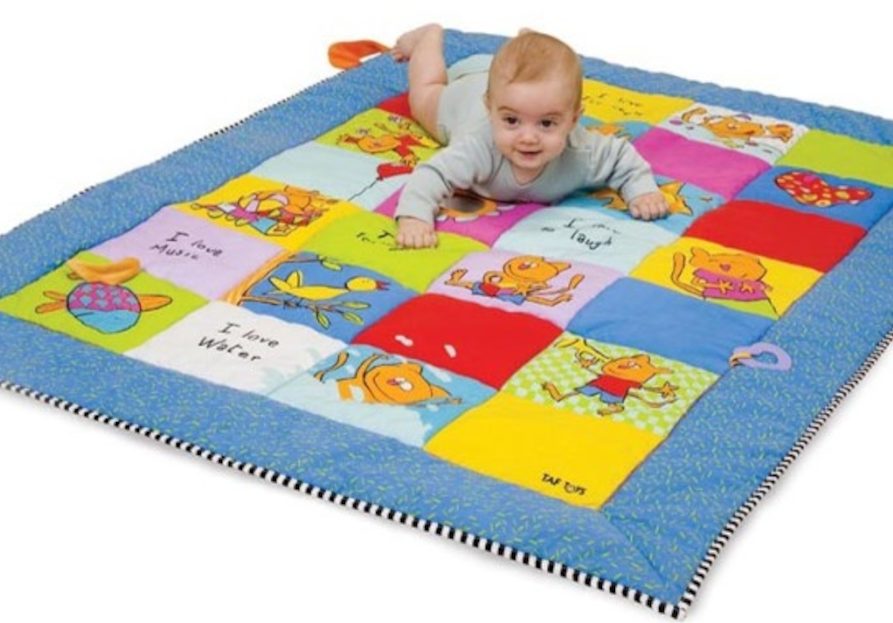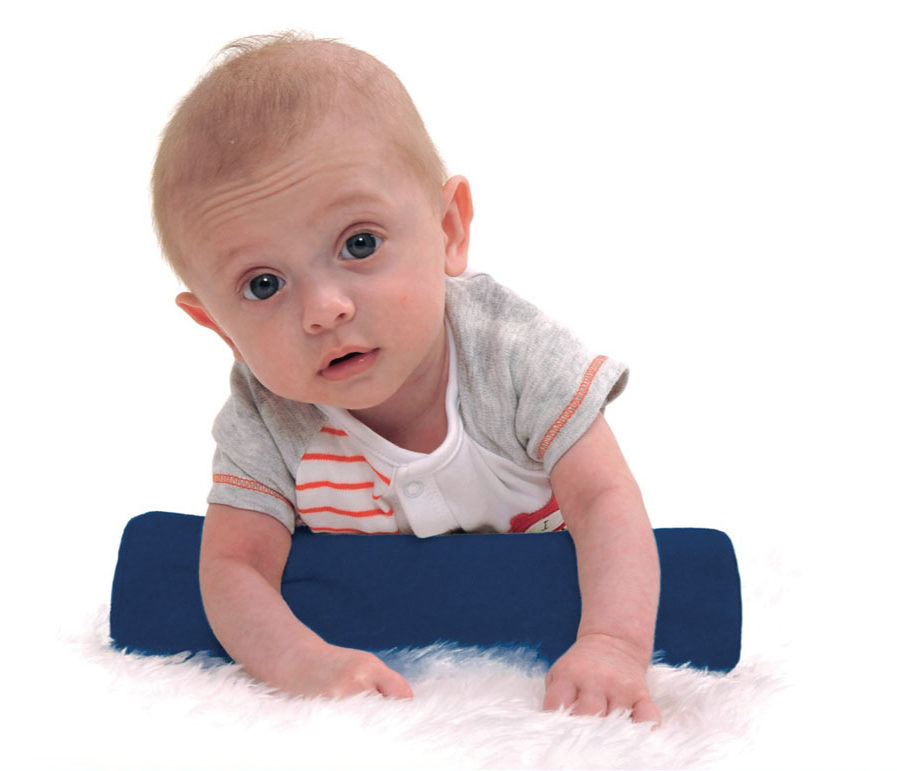Are current lifestyles limiting our children’s physical and academic potential? 
(Shop the Soft Manipulative Patchwork Large Playmat)
So why are tummy time and regular changes of position essential in the first few months of life?
Placing babies on their tummies to play every day (when awake, content and supervised) has numerous benefits:
- Helps improve ability to hold head up
- Builds strength in upper body and shoulders
- Helps develop core muscle strength and coordination
- Helps develop normal curve of the spine
- Begins to develop co-ordination and balance skills
- Helps baby learn about their body by taking weight through their arms
- Encourages baby to begin to learn about their body, to explore their surroundings and to open their hands for toys
- Gives them a sense of “really wanting that toy”, learning to assess risk, influence their environment and achieve – this becomes instilled for life!
- Essential to help baby learn how to roll over or push up into a crawling position. Crawling is fundamental to improved co-ordination later on
- Takes the weight off the back of the head to help avoid developing a flat head (plagiocephaply)
- Encourages symmetrical neck and back muscle development to reduce a head preference to one side (torticolis)
- Necessary for visual development as eyes learn to focus together
Babies must be placed on their back to sleep. BACK TO SLEEP, TUMMY TO PLAY…EVERYDAY!
Are tummy time, movement and regular changes of position really that important?
YES! Research clearly shows that “Gross motor performance is more advanced in infants who sleep supine and are placed in prone (on their tummy) while awake than in infants who slept supine but who had limited or no experience in the prone position when awake”. These gains and the self-confidence to explore appear to stay with children throughout life. Studies also confirm that early childhood skill development positively influences adolescent girls and boys participation in physical activity and fitness. We are all aware of the numerous health benefits associated with physical activity. Studies have shown that by ensuring children have the best start in terms of physical fitness they are more likely to continue their behaviour into adulthood.
Since the very successful ‘Back to Sleep’ campaign in 1992, there has been an increase in the number of children being referred for delayed gross motor development and plagiocephaly (flat head). This obviously has cost implications for our NHS, in addition to distress for families.
A study by FSID (Federation of Sudden Infant Deaths) in 2006 reported that 19% of mothers with babies 0-6 months never gave them tummy time play. Today, the age to trigger paediatric physiotherapy treatment for “delayed walking” is now considered to be 2 years old, rather than 18 months.
The American Physical Therapy Association (2008) reported on a study that prior to 1996, the prevalence of misshapen heads amongst infants requiring treatment was reportedly 1 in 300 live births; it is now 1 in 60. Current research suggests that up to 50% of babies under 1 will now show some extent of positional plagiocephaly (or a flat spot).
Postitional Plagiocephaly can occur because the skull is incredibly malleable, in preparation for descending along the birth canal. It is easily moulded by the pressure of the floor, cot, baby seat, bouncing chair etc on the back of baby’s head within the first few months of life.
When a baby is breastfed, a mother naturally changes the side her baby feeds from (and therefore head pressure). If a baby is bottle fed, it is very common for the caregiver to have a preferred, more comfortable side to feed from. Therefore, babies who are bottle fed, frequently feed from the same side have an increased risk of positional plagiocephaly.
Babies are born without the muscle strength to move their head from side to side, so in the first few weeks, it naturally rests to one side. Babies needs the opportunity and time to play on their tummy, back and sides, everyday – without restriction of modern contraptions in order to build up symmetrical neck strength and flexibility.
If the head preference is allowed to continue, the flat spot grows and it becomes even harder for baby to move their head fully, against gravity. A Torticolis (unilateral shortening of the sternocleidomastoid muscle) can occur before plagiocephaly but it frequently accompanies the persistent head preference. Therefore, both conditions should be looked out for.
A Torticollis often goes unnoticed within the first few weeks of life; parents may notice a lump in the muscle, level with the angle of the jaw which is apparent when the baby cries. It is generally a non-tender lump which reaches a maximum size in the first month of life before it gradually regresses.
However, it is more commonly noticed between 4-6 months, not as a lump, but as parents notice a head preference to one side or a head tilt to one side. This is caused by neck tightness on one side as the baby does not have the length in its neck muscles to be able to move its head fully to build up strong, counteracting neck muscles.
If left untreated there will be progressive deformities of the face and skull apparent within the first year – flattening of the face on the side of the affected muscle may result in considerable cosmetic deformity, with the level of the ears and eyes becoming more asymmetrical during the years of growth up to skeletal maturity. Research has also indicated that children are likely to experience increased ear infections, visual difficulties, delayed gross motor development and scoliosis (twisting of the spine) if left untreated. Early intervention is essential and it won’t just “clear up on its own” – something GPs and Health Visitors need to be more aware of.
As with many conditions affecting health, prevention is always best. Regular changes of position (including the position of baby’s cot – do caregivers always approach from the same side as baby’s head preference? If so, let baby sleep the other way around or move the cot). Active movement and allowing baby to play on their tummy and both sides can help. This also forms part of the physiotherapy and medical management for children with torticollis.
Early gross motor skill acquisition core strength are a vital part of child development, with the benefits continuing throughout life. Awareness of good practice needs to be raised and it is reassuring to know that the “tummy time play” message is now getting out to new parents.
The implications for primary children
In today’s world, there are many additional factors which are affecting child development. Babies often attend nursery from a very young age and are less able to explore their environment by themselves because of safety concerns; they are often confined to one room so that learning by experiment to climb stairs or crawl out of doorways is not always an option.
Babies often have a very structured day with a whole host of “scheduled activities” with little time to “just be” on the floor. They are only exposed to limited movement opportunities as they are transported/cocooned in car seats and travel systems. There are also whole host of contraptions on the market to strap baby into, keeping them “safe” whilst we get on with our busy lives.
These factors naturally contribute to babies becoming under-developed physically (especially core muscle strength and coordination), emotionally passive, unsure of exploring and less able to safely assess risk.
Families often live hours away from one another, so a run around the park with grandparents is often an infrequent treat, rather than a weekly occurrence. The computer-generation of children are growing up with improving technology from an increasingly younger age. This is leading to sedentary, poor posture as even 2 year olds are hunched over handheld games.
The Children’s Society believe “Play is one of the crucial elements of a good childhood”. A Unicef survey (2007) found British children were among the unhappiest in a league of 21 industrialised countries.
Alarmingly, new, unpublished research from a study of 503 children in Derby (aged 7-8 years), has shown that 94% did not achieve a “normal development” score when assessed against a gross motor development checklist. A pioneering 6 week school programme has been put in place, with 50% achieving “normal development” after the programme with associated improvements in handwriting, concentration and learning outcomes.
As the programme has been so successful it is now developing a programme for Early Years children (0-5 years) with an emphasis on tummy time play for the very youngest.
Another piece of new research shows that the number of children receiving NHS treatment for experiencing back and neck pain is increasing in Wales. 72% of primary aged children said they had experienced back and/or neck pain.
Children need good core muscle strength to carry their bags and maintain healthy upright posture. Could this be related to the amount of time spent with curved backs in baby car seats? A lack of core muscle strength from limited activity at an early age? Or being hunched over computers and hand-held devices?
Perhaps it is to do with our increasingly sedentary life full of technology, perhaps a fear of letting children play outside or in an unstructured way? With all the pressures on children and families today, we need to instil in our children, a desire to explore, assess risk and achieve from day one!
Alarmingly I think the introduction of a safety domes to cover babies sold by High Street retailers and online is reinforcing the sedentary, over-protective culture we live in. As a paediatric physio, I have serious concerns regarding this from a physical point of view and I wonder what an educational psychologist might make of it from an emotional point of view?
It is incredibly daunting as a new parent or parent-to-be with the sheer number and variety of professionally developed products and advice. Which can be trusted and justified?
Awareness of good practice needs to be raised and it is reassuring to know that the “tummy time play” message is now getting out to new parents.
The Jolly Back PosturePad Junior can be conveniently taken along with baby (used around the house, to grandmas, baby massage and other classes, on holiday, outside on a mat, on a changing mat with the non-slip mat if a baby suffers from reflux with nappy changes). It acts as a brilliant reminder to parents about the importance of tummy time play and the need for regular changes of position. It also helps lessen reflux after feeds and eases congestion if baby has a cold. Baby will be become familiar with their own space and PosturePad. Siblings can also use it.
Once rolling and sitting independently, the PosturePad Junior can be taken to nursery, school and used at home – it has so many uses.
With thanks to Lorna Taylor for this though-provoking article. Lorna is a Chartered Physiotherapist and Director at Jolly Back.
Shop our Babies and Toddlers range here




